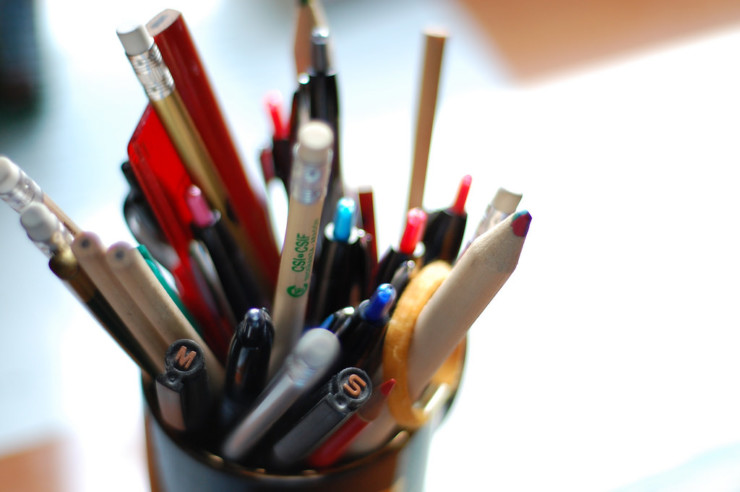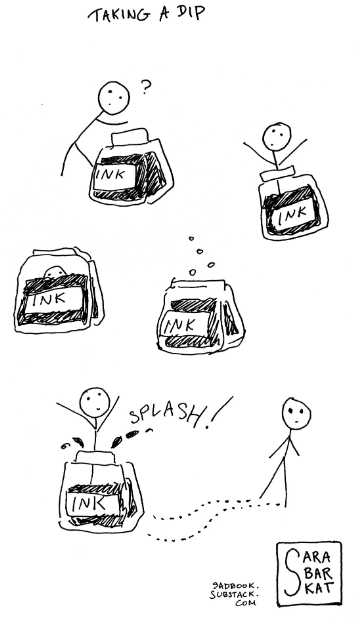When typing, letters have a kind of mechanical perfection. Each A looks like every other A; the spaces they occupy are consistent, a pattern that’s subliminally noticeable. Each line is ruled straight, and mistakes can (if typed on a computer) be removed in a way that no physical piece of paper could allow—without sensual mark of what had been there before: a shadow of color, or fibers slightly roughened. Thus, it seems that typed words might have been created only for the moment you read them, always existing in the now; there is no history. When you read an article or a book, on paper, and moreso online, there are no points on which your attention might catch. The type, the print, is created to be invisible, a there-ness that, by its very ubiquity, disappears.
I can always tell when a comic book has been lettered with a font, instead of by hand, even though most hand-lettered type looks, consciously, just as uniform. The font words seem somehow disconnected from the outlines of the speech bubble around it, without the awareness that would make each letter thicker or thinner as necessary. There is some gap, some kind of void, between the text and the art, the hand and the mechanics. If done badly, it can be very obvious—almost ugly. Even if done well, it has a feeling of its own.
It seems an irony to type out one’s thoughts about handwriting, but here we are. Because there is such ease in typing, the way it can move almost as fast as our thoughts, while handwriting slows everything down, this makes us have to think out a sentence in advance. The confidence it takes to compose is magnified when writing by hand. Each letter, each word, each sentence becomes: Yes. I thought this should exist as it is. Even crossing it out only leaves a mark on top of a mark; like sedimentary rocks, it keeps the history of thought and movement behind it, though there is something playful about the act, as well.
What happens when my hand connects with a page? When I can feel the impact of each letter on a real and tangible surface? There are no more lines—except as guides. But I can tilt them, turn them, stop them and re-start somewhere else, without pressing down a spacebar. When I type, everything, even pauses, becomes motion; in handwriting, a pause is only a pause, nothing more. The thickness of your writing—say with pen—can be changed with the smallest of moments’ thought by pressing down harder, and seeing the ink spread out into the fibers around it, leaving a groove—by writing in pencil, pressing so light the words are barely seen or shading everything so the soft, blurry lines become hard and defined. I can pick up one utensil, put down another, change color with every paragraph—not after, by adding color to the information of the words already stored in data, but as an inextricable part of the words.
This is how I wrote to my younger cousin, one summer. I started with a rainbow of colored inks, enough to half-fill a Gap clothes box. Green and brown, red and purple, blue and orange and black, all in small glass bottles with dropper tips. Dipping the pen takes care, precision, and then—the page is open to you. Lines can be filled with small, neat writing, or large, bold strokes. Colors can change, and did. Doodling in the margins became necessary. I wanted to make sure there were no mistakes—no misspellings, no crossed-out words. So before every letter would be another letter, written in pencil. There I would chronicle the pauses, the hesitations. The next letter, the copied version—that would be the work of art.
I’ve written other letters too, to other people. They all take on a different character. Letters written on vacation cover the front and back of double-sided paper, one page allotted for each day, the page filled with ink, or, more usually, pencil, in words so minuscule that everything squeezes together. Here I don’t worry about mistakes. Here I write the thoughts that pass through my head as I chronicle the small incidents, giving them reality, turning them into anecdotes and stories. Space becomes precious. There’s never any need to choose a font or to stick with cursive or print. I can combine them, can make a new script that connects each letter on the basis of the word itself, so that the tails don’t hang oddly, like a script-font when you’ve put too much space between the letters. A single word can grow to fill a line, can have its own flourishes, can fold itself up tiny, small. All to match the meaning! The feeling! No intermediaries necessary.
☞ The manicule. You probably recognize it. Originally, this was a hand drawn by hand: when people who owned books would draw in the margins of those they owned to leave their own comment, their own mark. The age of printing went on, the hand was turned into a symbol of its own, the convention fell off. Typing is a kind of magic: words appear out of thin air, with no connection to what’s around them. In an instant. But handwriting has its own kind of power: the power of the writer. The physical weight and movement of the tools that have created it, the space where it has been, the pages it resides on. And a connection, across any distance of time, of space—there was someone else here, who touched this too. Like a book from the library, with the cover taped back on, the pages tabbed and smooth from the hands of everyone who has read it, the doodles on the flyleaf in pencil. We were here. And you?
Featured photo by srgpicker, Creative Commons via Flickr. Post by Sara Barkat.
- Good News—It’s Okay to Write a Plot Without Conflict - December 8, 2022
- Can a Machine Write Better Than You?—5 Best (And Worst) AI Poem Generators - September 26, 2022
- What to Eat With Dracula: Paprika Hendl - May 17, 2022


Laura Brown says
What an interesting meditation on so many differences between typing and handwriting, and so many possibilities of handwriting. I love the question, “What happens when my hand connects with a page?”
And — my word, the word manicule! I knew the typographical symbol, but not the word, let alone its history as something hand-drawn. (One source I found after reading this called it the first post-it note.) Thank you for that lagniappe.
Sara Barkat says
What do you think happens? How does it work for you?
I’ve always loved learning about old books (like pre-Gutenberg stuff, and especially illuminated manuscripts) 🙂
Laura Brown says
First, I’m aware of the tactile qualities of the tools, the smoothness or toothiness of the paper, the feel of the pencil or pen in my hand. If it’s a pencil, and it usually is, then I either pause from time to time to advance the lead, or keep turning the pencil to find its sharpest edge until I have to sharpen it again.
I think different stuff comes out when writing by hand than when typing; this is why some writers I know do all their drafting by hand. And there’s a difference in what comes out on blank paper vs. lined paper, and on narrow rule vs. wide rule.
And it’s quieter, more contemplative. No sound of keys, no visual stimulation from the other things on the screen or the occasional notifications popping up. Less distraction. I can focus more deeply and then be surprised that an hour has passed.
So what happens? A stillness. Words I meant to say leading to words that surprise me.
Sandra Heska King says
—without sensual mark of what had been there before: a shadow of color, or fibers slightly roughened . . .
This post is so beautiful, Sara. Also the idea that typing seems meant for the present while the handwriting is meant for history. I find it much more difficult to toss a handwritten note away than one that’s been typed. I treasure my mother-in-law’s handwritten recipes and my mom’s written letters. I’ve noticed I write a lot of my own letters with her script.
Also there’s something about touching the paper someone else touched. They leave something of themselves—there’s a connection even after they are gone, they remain. I’ve taken to writing children we sponsor through Compassion by using their handy-dandy app. The good thing is that notes can be written spur of the moment and arrive a lot sooner. But there’s that missing personal connection. The kids write back by hand and even our 20-year-old draws us pictures.
One of my goals this year is to write more notes by hand. Thanks for this. You’ve reaffirmed my goal.
And I also had never heard of manicule s/l manicure. Than